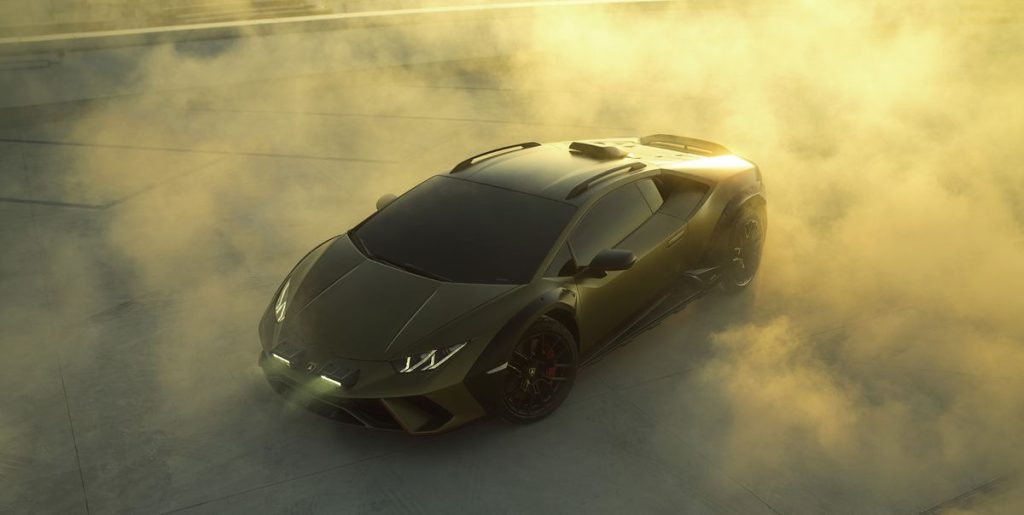2023 Lamborghini Huracán Sterrato Puts the Supercar in Rally Mode

The off-road version of the Lamborghini Huracán delivers on the promise of its 2019 concept.It’s got less power than the regular car and a lower top speed, but it adds a raised ride height and a Rally mode. Customer deliveries start next year for the Sterrato, which will be the last Huracán variant.
We first told you about Lamborghini’s plans to create a rally-raid-inspired version of the Huracán supercar back in 2019. Four years later, you’re looking at the production version. A limited run of 900 of the Huracán Sterrato will be produced for all markets, with deliveries starting next year. It will also be the last variant of the Huracán model line, and the last Lamborghini to be powered by the Italian company’s hugely charismatic naturally aspirated V-10 engine.
While the finished version looks very close to the original concept, much has been tweaked and tucked in the move to production. The biggest change is the arrival of a high-level central air intake for the engine at the back of the roof, coming as a result of feedback from the engineering team while the prototype was being tested in desert conditions. “It was eating too much dust,” Mitja Borkert, Lamborghini’s design director, admitted when C/D spoke to him about the car, “or rather the filters were getting blocked much too quickly.” The raised periscope will be able to sit in cleaner air and deliver it to the engine; both of the regular Huracán’s side intakes are now blanked out. All-wheel drive will be standard, and the Sterrato does without the active rear-steering system of faster road-biased Huracáns.
The new intake system means a slight reduction in power output for the Sterrato’s V-10. It now makes 601 horsepower, a 30-hp loss over the regular Huracán, although peak torque of 413 pound-feet is unchanged. It is hard to imagine the lesser figure will be a dealbreaker. Lamborghini claims a 3.4-second time to 62 mph, which sounds unexceptional for a Huracán—we blasted the rear-driven STO to 60 mph in just 2.6 seconds last year. But bear in mind that the Sterrato must dispatch the benchmark while wearing Bridgestone Dueler All Terrain tires as standard. The off-road rubber is also why it has a 160-mph speed limiter, which will make it the slowest production Lamborghini since the monstrous LM002 SUV went off-sale.
Suspension changes include a 1.7-inch increase in ride height and consequent improvement in ground clearance. Beneath the carbon-fiber arch extensions, the track has also increased by 1.2 inches at the front and 1.4 inches at the back. Lamborghini CTO Rouven Mohr says that suspension settings are significantly softer than in any other Huracán, although with switchable electromagnetic shock absorbers still allowing variable damping forces. “It was very challenging from a tire point of view to have a setup that was also stable at high speed,” he says, “but although the limits are obviously lower the car is also fun to drive on road, it is very progressive.”
Although it carries underbody protection and has reinforced sill covers, the Sterrato is designed for dusty and sandy conditions rather than rock scrambling. Like the Urus Performante it features a new dynamic setting called Rally, with Mohr saying that this will slacken stability control intervention to allow big drift angles on loose surfaces, while still stepping in if the car threatens to spin.
Lamborghini hasn’t released any images of the Sterrato’s interior yet, but we’re told that it will feature the new option of Sterrato Green microfiber trim as well as new infotainment functions including an inclinometer, a pitch and roll indicator, a compass, and a steering angle repeater. It will also come with a data recording system which, in its next iteration, will allow Apple Watch users to synchronize their heart rate with the telemetry.
Two of the Sterrato’s most distinctive features posed significant challenges for the engineering team, but were judged critical to delivering on the promise of the concept. The front auxiliary lights needed to be capable of passing tough pedestrian impact standards, and the roof rails required the car to carry loads where it was never designed to. Although loads will be limited to a modest 66 pounds—meaning no roof tents—Lamborghini predicts that buyers will opt to carry skis or lightweight bicycles.
The original idea for the Sterrato came when Mohr and Borkert, both then new arrivals at Lamborghini, were discussing their key automotive influences and agreed on the Lancia Stratos. That led to Mohr,who was then head of vehicle engineering, turning a durability-test Huracán into the original concept. As built, it was finished something very similar to the white, green, and red Alitalia livery the Stratos wore in competition, with the colors (but not the pattern) changed for the public images.
Both Borkert and Mohr agree that Lamborghini boss Stefan Winkelmann was critical to the creation of the production version, greenlighting the project almost as soon as he returned to the CEO role in 2020. The Sterrato will be sold alongside the existing Huracán range until the car goes off sale. We don’t have U.S. pricing yet, but in Europe the Sterrato will cost the equivalent of $270,000 at current exchange rates. We can expect to pay a supplement on that.
Will any Sterrato buyers actually use them in their intended environment? Mitja Borkert hopes so. “It is going to look better when it is dirty, or when it has some wear on it,” he says. Here’s hoping that happens.
This content is imported from OpenWeb. You may be able to find the same content in another format, or you may be able to find more information, at their web site.



